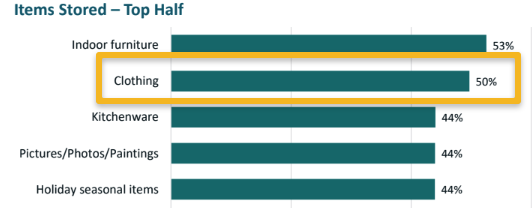Ever wondered how to store clothes long term without compromising their quality and freshness? The answer lies in proper packing and storage. This, however, is no small feat — it is an art that, when mastered, can keep your wardrobe in pristine condition, season after season.
The following practical tips and guidance can help you transform how you store clothes. After all, well-stored clothing not only lasts longer but retains its original charm and style.
Table of Contents:
- Sorting and Decluttering
- Choosing the Right Storage Containers
- Pack Clothes for Long Term Storage
- Ideal Storage Locations for Clothing Long-Term
- Maintenance and Regular Check-Ups
Sorting and Decluttering
Before we start packing, it is crucial to do some sorting and decluttering. This step may seem a bit tedious, but it lays the foundation for an organized and effective clothes storage system.
Evaluate and Sort Clothes
Review your wardrobe, examining each item’s condition, fit and usage frequency. Also consider each garment’s seasonality as you decide what to keep handy and what to store away, all with a goal of finding the best way to store clothes long term. Donate, give away or sell clothing you no longer want to keep to make room for more of the pieces that you want to preserve.
Clean Clothes Before Storage
Storing clothes isn’t just about folding and packing them away — cleanliness plays a significant role too. Before packing, every item needs to be washed or dry-cleaned to remove any dirt, stains and odors.
Only pack your clothes away once they are completely dry. Any residual dampness can encourage mold or mildew growth, undermining your clothes storage efforts. With a clean, dry wardrobe, you are all set for effective storage.
Choosing the Right Storage Containers
Choosing the right storage container is the cornerstone of a successful long-term clothes storage plan. As you ponder the type of clothing, available space and personal preferences, let’s look at common options, their advantages and disadvantages and identify suitable long-term clothes storage boxes.
Cardboard Boxes
- Pros: Cheap and recyclable, suitable for short-term use.
- Cons: Absorbs smells and liquids, prone to mold growth, not very protective, attracts bugs.
Plastic Bags
- Pros: Affordable and compact, excellent for quick transport.
- Cons: Traps and accumulates moisture leading to mildew, not suitable for long-term clothes storage.
Vacuum Bags
- Pros: Space-efficient and suitable for seasonal clothing storage.
- Cons: Extended compaction can damage clothes, making them less efficient for long-term clothes storage.
According to Karina Toner, Operations Manager at Spekless Cleaning, these bags are game-changers for short-term purposes, especially for storing bulky items. “When I was preparing for a long trip and needed to pack my winter clothes, I decided to give these bags a try,” Toner said. “I was amazed at how much space I saved by compressing my bulky sweaters and coats. Plus, when I arrived at my destination, my clothes were still fresh and protected from any potential moisture.”
Garment Bags
- Pros: Cotton garment bags are breathable, keep out dust and are excellent for storing clothes long term, particularly items like suits or special occasion dresses.
- Cons: Plastic garment bags can trap moisture, leading to mold or mildew growth.
Toner worked with a client who was moving to a new home and needed to pack up her entire wardrobe. Her suggestion was to use garment bags.
“She had a diverse collection of delicate fabrics and special occasion outfits that she was worried about wrinkling,” she said. “We suggested storing these items in breathable garment bags, which allow for proper airflow and prevent creases. Our client followed our advice and was thrilled with the results. She mentioned how easy it was to access her clothes when she needed them without having to worry about ironing out stubborn wrinkles.”
Plastic Storage Boxes
- Pros: They keep out pests, humidity, dust and water, making them one of the most efficient ways to store clothes, especially long term.
- Cons: They can be expensive and prone to warping or cracking if overpacked.
Wardrobe Boxes
- Pros: Ideal for garments that need to be hung up, they allow airflow throughout the garment.
- Cons: Like cardboard boxes, they can absorb liquid and odor and are only good for a few uses.
NOTE: Always select high-quality containers for your long-term clothes storage. It might cost more upfront, but it will protect your clothes from damage, making it a sound investment.
Pack Clothes For Long Term Storage
Proper packing and organizing of your clothes not only maximizes space but also maintains their quality. Here are some efficient strategies for arranging your wardrobe:
Folding Techniques for Different Clothing Types
For most clothes like shirts, pants and sweaters, a simple fold is adequate. Aim to minimize wrinkles and maximize space. For delicate items, consider tissue paper or soft cloth interleaving to avoid creasing. Remember, an efficiently folded garment means less ironing later.
Use Space-saving Techniques and Creative Ideas
Toner, a seasoned professional in space saving techniques, shares her unique but effective approach:
“Roll instead of folding: It felt counterintuitive to me at first, but it turns out, rolling clothes instead of folding them can save space and reduce wrinkles,” she said. “This technique is particularly useful for T-shirts, jeans and other casual wear.”
Another great tip is using shower caps or plastic bags for shoes to safeguard your clothes from contact with the soles of your shoes. This creates a protective barrier that effectively prevents dirt and debris from transferring onto your garments, keeping them in immaculate condition.
Categorize and Label Containers
Organize your clothes by type, season or frequency of use. Label your containers to save time rummaging through boxes when you need a specific item.
Packing and organizing clothes is a blend of technique and creativity. The goal? Keeping your clothes in great condition so they are easy to access and optimally stored for the long-term.
Ideal Storage Locations for Clothing Long-Tterm
The best way to store clothes long term is closely tied to choosing the right storage location.
Your clothes and shoes require a cool, dry, dark and well-ventilated area, away from direct sunlight or excessive humidity. Garages and attics, although convenient, usually experience temperature extremes and lack adequate ventilation, making them unfavorable for clothing preservation.
Alternatively, consider under-bed storage or climate-controlled storage units. The latter are especially beneficial as they maintain stable temperature and humidity levels, providing your clothes with the best environment for long-term storage.
When it comes to storing shoes, it is important to guard against pests and mildew. Deter pests using cedar chips or balls instead of mothballs, and tackle mildew with silica gel packets or cedar shoe trees that absorb moisture and help maintain your shoe’s shape.
Remember, the most efficient way to store clothes involves careful preparation, protection and location selection. The ‘cool, clean, dark and dry’ rule is your go-to guide for successful long-term clothes storage.
Interesting Fact: Based on a 2023 Demand Study that the Self Storage Association conducted, data collected over 2022 shows that at least half of the consumer storage unit renters store clothing in their units!

Credit: Self Storage Association – selfstorage.org
Maintenance and Regular Check-ups
Ensuring the longevity of your stored garments requires not just proper packing but regular maintenance too.
Periodically Inspect Stored Clothes
Vigilance is key in clothing storage. Keep an eye out for signs of damage, pests or moisture during routine inspections of your stored items. Should you spot any issues, immediate action can prevent further harm.
Rotate Seasonal Items
With the changing seasons, it is crucial to rotate your clothing items. By storing off-season clothes properly and keeping current items in use, you maintain freshness and prevent damage. Through consistent upkeep, your clothes will stay in prime condition for the long term.
Store Clothes Long Term the Right Way
Whether it is for six months or six years, proper clothes storage is a vital step in extending the lifespan of your garments. From evaluating your wardrobe, choosing the right storage containers, to smart packing, each step is crucial. By mastering how to store clothes long term, you are investing in the longevity of your wardrobe.
Let’s cherish our clothes and keep them in their best condition for as long as possible with these useful tips.
Storing Clothes FAQ
Are mothballs bad for my clothes?
Moth Balls are not necessarily bad for your clothes, but are full of toxic pesticides and chemicals, making them unsafe for humans and pets. Look into alternatives like cedar wood, whether it's in the form of a cedar chest, cedar chips, or a cedar oil spray.
How long is too long to store my clothes?
You want to make sure and check on your clothes periodically, especially if they are in a storage unit. At least once a year you should refold, maybe even rewash your clothes to increase their longevity. You can store your clothes for years and years if you take the right precautions.
What is the best way to fold clothes for long-term storage?
It's important to fold your clothes instead of throwing them in a bag or bin and calling it a day. Marie Kondo, organization expert, has blessed us with her space saving folding technique that allows you to see all of your clothing items at once. It seems complicated at first, but give it the old college try before you ditch this method.




